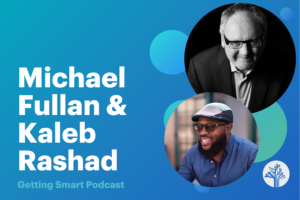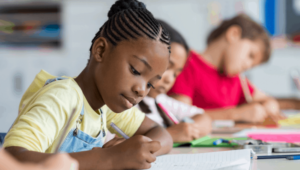Why High-Quality Learning Opportunities Must Be Personalized to Each Learner
Key Points
-
Personalized learning enhances student motivation and achievement by aligning education with individual interests and goals.
-
studentCompetency-based learning prepares students for real-world challenges by allowing them to progress at their own pace and focus on skill mastery.

In August, we published the following design principles, which we believe are core for every learner to thrive. In this blog, we present our rationale for elevating personalized learning – that all students deserve personalized learning experiences that are adaptive to how and when learning occurs and competency-based.
Imagine a classroom where students feel seen, heard, and empowered to pursue their unique path, where they’re explorers, creators, and thinkers. In today’s fast-paced and diverse world, education must be as dynamic as the learners it serves. That is where personalized learning comes in. This transformative approach tailors education to individual strengths, interests, and goals, making learning more engaging, effective, and empowering for all.
What is Personalized Learning?
Personalized learning is an educational approach that adapts to fit the unique needs of each student, empowering them to shape their learning journey. This involves giving students a choice and voice in what they learn, how they learn, and even when and where learning occurs. Competency-based learning is a component of this approach, where students advance based on their mastery of specific skills rather than time spent in class.
Aurora Institute defines personalized learning as ‘tailoring learning for each student’s strengths, needs, and interests—including enabling student voice and choice in what, how, when, and where they learn—to provide flexibility and support to ensure mastery of the highest standards possible.’
The ultimate goal is to ensure that each student achieves high standards by progressing at their own pace and focusing on what matters most to them.
Why Does Personalized Learning Matter?
Research consistently supports the positive impact of personalized learning. When students have a say in their education and engage with topics that interest them, their motivation, engagement, and achievement improve. Personalized learning also emphasizes critical metacognitive skills—such as planning, self-monitoring, and evaluating one’s progress—essential for becoming independent lifelong learners. Students who feel empowered and in control of their learning are more likely to overcome challenges and develop a growth mindset, which enhances both academic and social-emotional outcomes.
Beyond academic achievement, personalized learning prepares students for future careers by fostering critical thinking, problem-solving, and adaptability—indispensable skills in our rapidly evolving world. Students who engage in competency-based learning are better equipped to navigate complex real-world situations, as they have already mastered essential skills through hands-on, meaningful experiences.
Evidence Behind Personalized Learning
Research has consistently demonstrated the effectiveness of personalized learning in enhancing student outcomes. One reason for personalized learning’s success is its alignment with intrinsic motivational drivers. Aurora Institute notes personalized learning aims to “open student pathways and encourage student voice and choice in their education.” By giving students greater autonomy and control over their learning, we tap into their intrinsic motivation and support a deep sense of engagement and ownership.
Studies have shown that students who participate in personalized learning environments demonstrate higher levels of engagement and persistence, especially when learning aligns with their interests and career aspirations.
Personalized learning environments also foster a sense of agency and identity as students take ownership of their educational journey. This empowerment not only enhances their academic performance but also cultivates essential skills for lifelong learning and adaptability, such as critical thinking, problem-solving, creativity, and resilience.
Examples of School Design
- Iowa BIG, Iowa: Learner-Centered Design and Project-Based Learning Iowa BIG is a learner-centered school that provides ongoing, community-facing, project-based experiences. Students engage in projects deeply connected to their community, fostering a strong sense of relevance and identity.
- Highland Tech Charter School, Alaska: Highland Academy is a 6th-12th grade school that promotes competency learning through student-centered, individualized activities and varied assessment strategies. Students work at their own pace, mastering core content. Technology integration and project-based assessment are critical components of Highland’s rigorous model. The school emphasizes social-emotional development and supports students in setting their own learning goals.
- EDGE Microschool, Missouri: EDGE is a personalized microschool located within Liberty, a High School in Liberty Public Schools. It is focused on real-world problem-solving and global impact. Students at EDGE have a significant say in their learning, setting goals, designing projects, and choosing how to demonstrate their knowledge. Highly qualified teachers provide guidance and support while fostering a student-driven learning environment.
- Gibson Ek, Washington: The motto at Gibson EK is “Real World, Real Learning, Real Life.’” Students do not enroll in traditional courses, instead they “earn academic competencies through projects” and work with a mentor through internships two days per week. The school is designed on principles such as “Stop learning for school, start learning for life.”
- Innovation, Design, Entrepreneurship Academy (IDEA), Dallas: IDEA strives to provide a personalized education for every student. Starting in tenth grade, students are supported and advised to look into the community to find their interest in choosing an internship. They have advisory every morning and every student receives AVID training. There are no sports but instead, IDEA offers student-run clubs for academics and interest on Fridays. It was evident throughout the building that IDEA operates as a community or a family, more than a school. In fact, there are regular “family meetings” or restorative practice circles that are student-led and support learners in developing conflict resolution skills.
- Health Leadership High School, New Mexico: Health Leadership High School eliminates traditional classes in favor of collaborative projects with community health providers. This model engages students in real-world health issues and helps them develop competencies relevant to their future careers.
- Crosstown High School, Tennessee: Crosstown High is a learner-centered public charter school that engages students in meaningful, project-based work and authentic relationships that will prepare them to be self-directed, lifelong learners. We are located inside Crosstown Concourse, a landmark adaptive reuse development project in the heart of Memphis.
- The Parker School, Massachusetts: Using 10 Ten Common Principles, this school emphasizes core aspects of personalized learning including: Learning to use one’s mind well, Democracy and Mastery.
Examples of Networks
- Building 21: Building 21 competency progressions empowers students by giving them control over their learning journey. Students are actively involved in setting goals, tracking their progress, and reflecting on their achievements.
- Teton Science Schools (TSS): This small network of schools integrates competency-based education with place-based learning. Its mission deeply embeds place-based education principles.
- Da Vinci Schools, California: Da Vinci leverages a gen AI app that uses self-identified passions, interests, and career possibilities to personalize student projects. Teachers embed specific expectations for projects while AI ensures outcomes are met by honoring students’ unique and varied pursuits. Students can also explore various career paths using SchoolJoy which relies on AI to analyze student interests, skill sets, and local market data to suggest best-fit career paths. AI enables students to learn about career options beyond their neighborhood and can pivot based on student passions and curiosities.
Examples of K12 Systems
- Northern Cass School District, North Dakota: Northern Cass School District embraces competency-based education to ensure every student is “choice ready” by graduation. It works closely with local businesses and community organizations.
- Concord Community Schools, Michigan: Concord is dedicated to personalized learning, empowering every student to reach their full potential. Concord aims to cultivate students’ passion for learning, social responsibility, and self-belief by fostering a collaborative environment.
- University Charter School, Alabama: University Charter School deploys personalized playlists in most classrooms, clearly connected to required standards and full of voice and choice in terms of pace and assessment.
- Cajon Valley Unified School District, California: CVUSD’s “World of Work” framework helps students reflect on their strengths, interests, and values, preparing them for future success.
- Chugach School District, Alaska: Chugach School District pioneered competency-based education and tied it to place-based learning, involving students in discussions about their learning goals and progress.
- Lindsay Unified School District, California: Lindsay focuses on personalized learning paths and mastery-based progression, ensuring that each student’s unique needs, strengths, and interests are addressed.
- Westminster Public Schools, Colorado: This district, north of Denver, organizes learning around competency-based progression, allowing students to advance upon mastery of specific skills. They have an established partnership with Marzano High-Reliability Schools.
Personalized learning is a transformative approach that tailors education to meet the unique needs and interests of each student. By adopting competency-based learning, using technology to individualize instruction, and promoting student agency, schools can create an environment where every learner has the opportunity to thrive. As we look to the future of education, embracing personalized learning is not just beneficial—it is essential. By doing so, we can ensure that every student is prepared to navigate and succeed in an ever-evolving world. Let’s work together to make education more personalized, engaging, and effective for all.
After reading this, do you believe personalized learning should be one of the most crucial design principles in education? Share your thoughts with us at [email protected]!
Recommendations
To successfully adopt personalized learning, educators, and schools can use the following strategies:
- Move Beyond Seat Time, Measure Learning, Not Minutes. Adopt Competency-Based Learning. The transition from traditional time-based models to competency-based approaches where students advance by demonstrating proficiency.
- Co-create Learning Journeys and Develop Personalized Learning Plans (PLPs): Create individualized learning plans co-authored with students, outlining goals, strengths, and areas for improvement. This fosters a sense of ownership and ensures that learning is tailored to each student’s needs.
- Leverage Technology: Use digital tools and adaptive learning platforms to offer personalized experiences that match students’ learning styles and paces.
- Cultivate a Growth Mindset: Provide ongoing, high-quality feedback to encourage students to reflect on and adjust their learning strategies. This helps students develop resilience and believe in their ability to improve through effort.
- Students Become Take the Drivers Seat. Empower students to make meaningful decisions about their learning, such as choosing project topics or deciding how they will demonstrate their knowledge. This enhances motivation and personal investment.
- Equip Teachers for Success and Invest in Professional Growth. Support professional learning for teachers to help them design personalized learning experiences and use data effectively to inform instruction.
- Engage Families and Communities: Build partnerships with families and communities to support personalized learning goals. This could involve collaborating on community-based projects or involving parents in setting and reviewing learning goals.
- Design for Discovery, Create Spaces for Personalized Learning. Creating flexible learning environments that accommodate different activities and allow collaboration, independent study, and project-based learning.







0 Comments
Leave a Comment
Your email address will not be published. All fields are required.